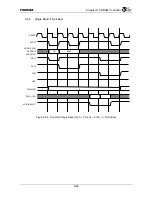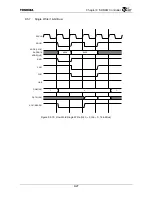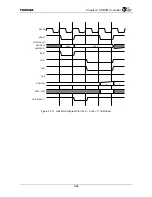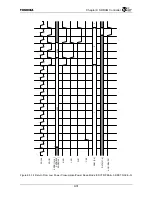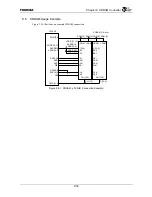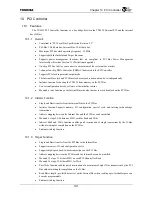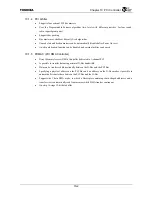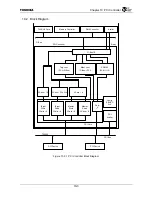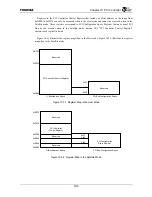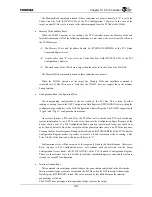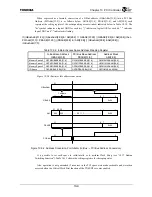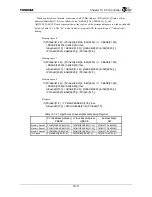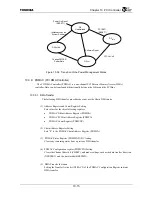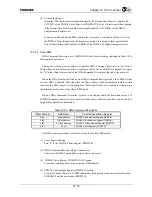
Chapter 10 PCI Controller
10-4
10.3 Detailed
Explanation
10.3.1 Terminology
Explanation
The following terms are used in this chapter.
•
Initiator
Means the bus Master of the PCI Bus. The TX4925 operates as the initiator when it obtains the
PCI Bus and issues PCI access.
•
Target
Means the bus Slave of the PCI Bus. The TX4925 operates as the target when an external PCI
device on the PCI Bus executes PCI access to the TX4925.
•
Host mode
One PCI Host device exists for one PCI Bus. The PCI Host device uses a PCI configuration
space to perform PCI configuration on other PCI devices on the PCI Bus.
The TX4925 is set to the Host mode if the ADDR[15] signal is High when the RESET* signal is
being deasserted.
•
Satellite mode
A PCI device other than the PCI Host device accepts configuration from the PCI Host device.
This state is referred to as the Satellite mode.
The TX4925 is set to the Satellite mode if the ADDR[15] signal is Low when the RESET*
signal is being deasserted.
•
DWORD, QWORD
DWORD expresses 32-bit words, and QWORD expresses 64-bit words. According to
conventions observed regarding MIPS architecture, this manual uses the following expressions:
Byte: 8-bit
Half-word: 16-bit
Word: 32-bit
Double-word: 64-bit
10.3.2 On-Chip
Register
The PCI Controller on-chip register contains the PCI Configuration Space Register and the PCI
Controller Control Register. The registers that can be accessed vary according to whether the current
mode is the Host mode or the Satellite mode.
An external PCI Host device only accesses the PCI Configuration Space Register when in the
Satellite mode. This register is defined in the PCI Bus Specifications. A PCI configuration cycle is used
to access this register. This register cannot be accessed when in the Host mode. Section 10.5 “PCI
Configuration Space Register” explains each register in detail.
The PCI Controller Control Register is only accessed by the TX49 core and cannot be accessed from
the PCI Bus.
Summary of Contents for TMPR4925
Page 1: ...64 Bit TX System RISC TX49 Family TMPR4925 Rev 3 0 ...
Page 4: ......
Page 15: ...Handling Precautions ...
Page 16: ......
Page 18: ...1 Using Toshiba Semiconductors Safely 1 2 ...
Page 40: ...3 General Safety Precautions and Usage Considerations 3 18 ...
Page 42: ...4 Precautions and Usage Considerations 4 2 ...
Page 43: ...TMPR4925 ...
Page 44: ......
Page 54: ...Chapter 1 Features 1 8 ...
Page 58: ...Chapter 2 Block Diagram 2 4 ...
Page 88: ...Chapter 4 Address Mapping 4 12 ...
Page 226: ...Chapter 8 DMA Controller 8 58 ...
Page 260: ...Chapter 9 SDRAM Controller 9 34 ...
Page 480: ...Chapter 15 Interrupt Controller 15 32 ...
Page 554: ...Chapter 19 Real Time Clock RTC 19 8 ...
Page 555: ...Chapter 20 Removed 20 1 20 Removed ...
Page 556: ...Chapter 20 Removed 20 2 ...
Page 564: ...Chapter 21 Extended EJTAG Interface 21 8 ...
Page 580: ...Chapter 22 Electrical Characteristics 22 16 ...
Page 588: ...Chapter 24 Usage Notes 24 2 ...


